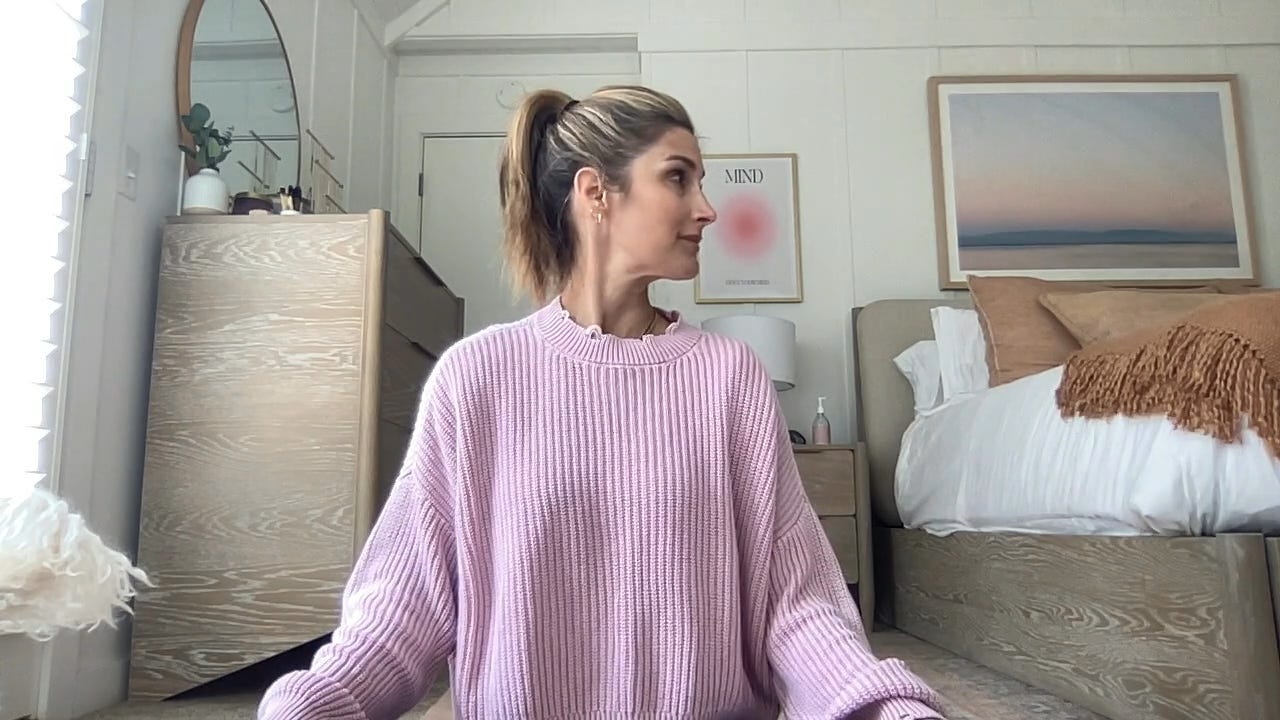I've been thinking a lot about emotional regulation and our nervous system as ADHDers lately. I know there's a lot of talk out there around trauma, the nervous system and emotional regulation right now, but I think sometimes it can all be a bit muddled and confusing.
How do we apply these tools and these concepts?
How are they relevant to our lives?
How do they impact us?
It can be a bit abstract in my opinion. Some of these concepts and how they impact us as a community have been becoming more clear for me lately so I wanted to share them with you.
Why emotional regulation is challenging as ADHDers with high-sensitivity
People with ADHD have more sensitive nervous systems. We are interpreting the world around us with greater intensity and it can translate to: more trauma held in our bodies and more dysregulation.
Emotional regulation is an executive functioning skill, which falls under our challenge as people with ADHD. Our executive functioning skills are weaker than the typical person's. So regulating these big feelings (on top of being more sensitive in general to our experiences) it's hard, right?
I've been connecting the dots about how the actions in our lives, equal the results of the lives that we're living.
Our actions are products of our thoughts and our beliefs. And our thoughts and our beliefs are products of the emotions we feel. And our emotions are the result of our nervous system settings. So it's like this cycle.
It's really bringing me back to why understanding our nervous system and feeling safe in our bodies is so essential to living the lives that we want to be living, to feeling the way that we want to feel, to be taking action on the things that are really going to move the needle forward in ways that we desire in our lives, that are going to allow us to show up and be present and regulated in the way we connect with the people that we love.
Why self-regulating our nervous systems is so important
I've been having this epiphany of, “Okay, this is why it matters. This is why understanding our nervous system and how to create safety in our own bodies is so essential to all things. It's the foundation and root cause of everything.”
It's like pulling a weed, right? If we're just going to pull the tops and leave the root below, the problem is still there. We've got to get to the root to really create the change that we desire in our lives and find the solutions that actually make the impact that we're looking for.
I love this quote from Deb Dana: “We do the work when we don't need it. So it's there for us when we do.”
What she's referring to is this nervous system work.
Understanding how to create safety in our bodies when we are feeling triggered, dysregulated or heightened. It highlights why it's so essential for us to understand our nervous system, understand our bodies, and understand what the high payoff tools are for us to bring us back to a state that feels regulated.
And it's not the same for everybody, right?
I think that's the part that also gets a little convoluted. We all have different nervous systems. Just like our brains, our nervous systems are unique, our experiences, our traumas, the things our bodies are holding.
We respond differently to different things.
So it's really not a one-size-fits-all. It's really about understanding what is a high payoff reward for your particular nervous system.
And that takes a little bit of experimenting and figuring it out.
This is the work I’ve not only done for myself but that I support ADHD Moms with in my paid community resources too. (Want to learn more? Click here)
As Deb Dana says, “Do the work when we don't need it, so it's there for us when we do.”
The more we explore the different tips and tricks out there the more we can make a menu for ourselves of what works. Whether that’s in your notes app, in a journal, in my freebie guide etc.- writing down your go-to strategies that help you self-regulate and feel safe in an easily accessible place (when you are calm and regulated) is a way of setting yourself up for success, rather than spinning out.
So I wanted to give you some guidance and tools to help you create your own menu. Here are a couple things that I love:
5 Self-Regulation Strategies to Try
EFT Tapping
I love EFT tapping. If you, don't know EFT, it's one of the resources here on Substack you can grab, and I walk you through it. Emotional Freedom Technique (EFT) tapping is a tool that helps us move back into feeling calm and safe. By tapping on acupressure points in a specific order, while reciting affirming phrases- we can move our body out of dysregulation and back to center.
Shaking Our Bodies
Shaking our bodies is another one. Honestly, for a minute, just shaking your arms, jumping your legs, turning your head, literally just shaking your body. And then coming back- can help shift the thought loops that we're going down and bring us back into our body.
Relaxing Our Optic Nerve
There's something where we can relax our optic nerve. Where we literally put our hands over our eyes. Imagine the palm of your hand going over your eyes and then you open your eyes and it’s completely dark. Then taking three long, deep inhales and exhales.
That's another one that's quick and easy to do.
I like having tricks where I know I could do them on the spot. I love to take a walk in nature. I love to meditate. I love yoga. But those aren't quick-on-the-go ones we can apply when we're maybe at a meeting with other people or we're driving our kids in the car.
It's nice to have ones that we can go to that have a quick payoff at the moment.
Havening
Another one I love is something called havening. And if you're not familiar with havening, essentially, you're going to slowly rub your hands over each other. You can even rub up your forearms. If you want to try it now, try it now.
Notice how it feels to be the hand that's touching your hand. Or your arm? Or the fabric on your shirt?
And then notice how it feels to be the hand or the arm that's being touched.
And as you slowly do this alternate between your awareness of how it feels to be touched and how it feels to be touching your hands- for me, this very quickly brings me back into my body and to feeling safe.
Grounding
Another super easy one is just like noticing your feet on the floor. Pressing your feet into the ground. You can literally be on a zoom call or at a meeting and no one would notice you doing this. You know, just pressing your feet into the floor, noticing the sensation of your feet on the floor or your butt on the chair. That just grounding you into your body.
Assessing Which Tools are High Payoffs for You
There's a great way to assess these tools, if you want to figure out which are high payoffs for you. You can simply turn your head to the right. And notice what you see. And then turn your head to the left and notice what you see. And then try some of these different nervous system regulation tools, like havening, the optic nerve, EFT, and then once you've done the tool, do the same assessment at the end. Turn your head and notice if you have a greater range of motion and if you can see further in one direction or further in the other direction.
That's a great way to check in with your body and see if this particular tool works for your nervous system. I can feel right away like, okay, this worked for me and you probably are the same way. But it's a fun way to see in your body, how much it relaxed your system or didn't.
Creating Your Self-Regulation Toolbox
So I really recommend making a list and having it wherever it's going to be convenient for you to see, to reference, to remember. So when you are in that moment and you need it, you have that quick way to bring yourself back into your body.
In fact I made a PDF guide to walk you through these steps and give you space to assess the techniques that work best for you:
Because it's so hard as people with ADHD when we're so sensitive and we're experiencing things in the world that are validly hard because the environments so often aren't set up or designed for the way that we think and do and thrive.
Self-regulation is so important because when we care for our nervous system, it directly impacts the actions we take and the lives we create.
So if we go back to that, it starts with the nervous system.
It drives our emotions. And our emotions drive our thoughts. And our thoughts drive our actions. And our actions drive the results in our lives.
It just all makes so much sense that the nervous system is the root, right? And that's why I just wanted to get on here and share this with you guys, because I think there's just so much talk out there about the nervous system, about trauma, about regulating and co-regulating and all of that, but sometimes it can just be like:
How does that apply to me?
And why does it matter?
And how do I even do this in a way that impacts my life?
And so as promised in this space, I always want to be providing you with resources and ah-has that I'm having in my life and with my clients so that you can apply them in yours.
I would love for you to try some of these things. If you feel up for it, leave me a note in the comments if:
you liked any of these
or if any of these were high payoffs for you
or if you want me to do any more videos where I go more in-depth with some other nervous system tools
P.S. Want to create your own self-regulation toolbox together? I’d love to support you- checkout my free guide here and if you’re ready to go deeper- explore my paid community for ADHD Moms here.






















